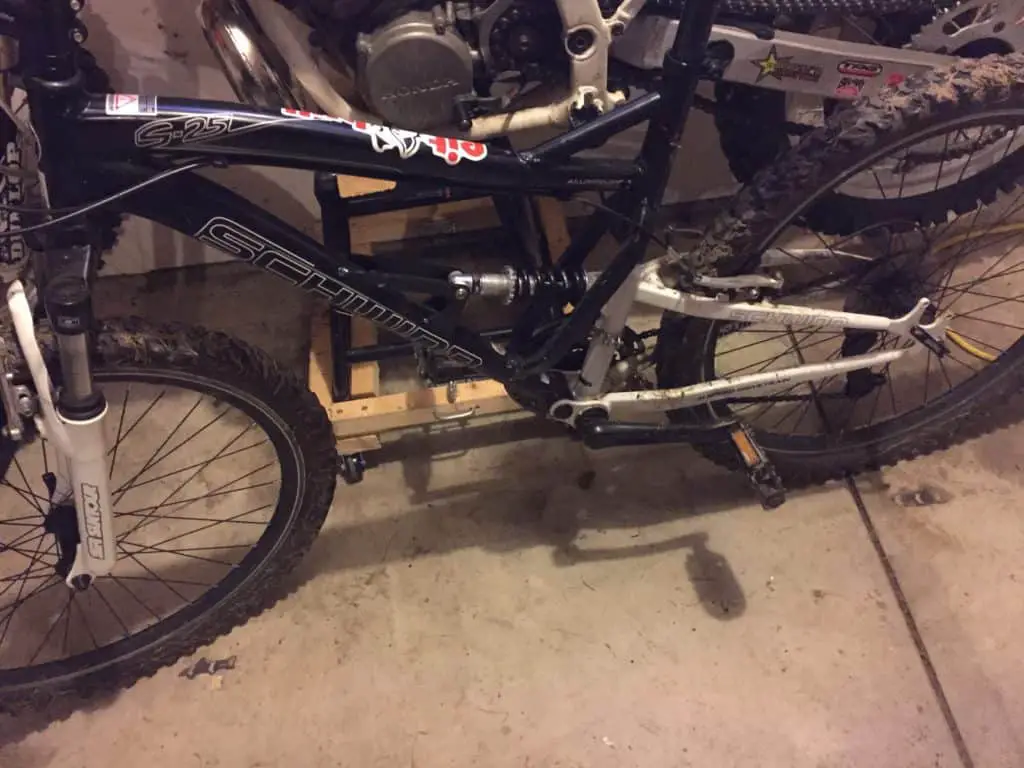I was riding my mountain bike the other day and started noticing similarities between how I cornered on my mountain bike and my dirt bike. Then I started noticing how they were different. This led me to examining the topic in more detail.
There are many differences between a mountain bike and dirt bike such as weight, effect of shifting body weight, propulsion, price, maintenance, noise, machine complexity, distance covered on a ride, location of brakes, and places to ride.
While I just listed the differences, let me give a little context to each one.
Weight Difference Between A Dirt Bike and Mountain Bike
The biggest difference that you’ll notice between a dirt bike in mountain bike is the weight. You can see this just by looking at the two.
A dirt bike will weigh anywhere from 200 to 275 pounds whereas a mountain bike weights anywhere from 20 to 35 pounds. This also assumes that it is not an e-bike. E-bikes will weigh even more than a traditional mountain bike.
To physically feel the difference, walk into a motorcycle shop and try standing the motorcycle up. Then walk into a bike shop, stand a mountain bike up. Slowly rock each one back-and-forth and you’ll quickly see the difference.
The weight factor also affects how you ride each one. The difference, while exaggerated, illustrates the point with slowing down each machine. One is like slowing down a freight train, the other is like stopping a car. And this assumes that both of them are using disk brakes. If you’re on a mountain bike with pinch brakes, it will have a longer stopping distance. I can tell you this is what I have on my mountain bike and it sucks.

The second big difference is how each machine corners. We do not distribute the weight the same on a mountain bike as it is a dirt bike.
Shift Body Weight On a Dirt Bike Vs A Mountain Bike
Besides the weight, we need to consider the effect body movement has on each machi
It’s really a matter of simple math. Your bodyweight will be a much higher percentage and several times more than the weight of a mountain bike. As a percentage of the dirt bike, your weight will be somewhere between 50 to 100% of a dirt bike.
When you shift your weight forward on a mountain bike, you’ll have a much greater effect on the handling versus a dirt bike. The same can be true when you look at shifting weight for cornering, jumping, or doing a wheelie.
Not that shifting your weight around on a dirt bike is useless. The shift in weight does not affect the machine as much on a dirt bike.
Propulsion Difference Between A Dirt Bike And Mountain Bike
Again this seems obvious, but how each machine moves or what propels the machines is different in each case.
We will motivate a dirt bike to move by a two-stroke or four-stroke engine. You pedal a mountain bike
Considering how this affects the riding style on each machine, it will have a different effect on the rider. A dirt bike rider does not exert as much effort in some riding conditions. Let’s use riding up a hill for illustration.

A dirt bike rider will lean forward some and carefully manage the forward movement through proper throttle, clutch, and brake control. A mountain bike rider will also lean forward, but have to pedal, which requires more effort because he cannot keep a static foot position. It involves moving his legs helping propel the bike forward.
Price Difference Between a Dirt Bike And Mountain Bike
There are many things to consider and the influence the price of any individual mountain bike or dirt bike. However, we can talk about the differences in generalities. I must note though, you may see situations that would be contrary to what we discuss.
Mountain bikes will be less expensive than dirt bikes. New dirt bikes can run anywhere from $6500 to more than $12,000. Mountain bikes can run anywhere from a few hundred dollars to $10,000 on the upper end of things.
This makes buying a mountain bike much harder than buying a dirt bike. Specifically, the price range difference on the mountain bike as you can see is much larger.
Mountain bikers face larger marginalized costs when comparing the different features.
Maintenance Differences Between Dirt Bikes And Mountain Bikes
As you can imagine with having different machines, the maintenance requirements on each of them will be substantially different. The mountain bike will be easier to maintain overall since this is because of the fewer number of parts it has.
Here are a few of the larger differences
The first difference is the fact you have an engine with the dirt bike and you have a crankset with pedals on the mountain bike. The dirt bike will require the oil changed whereas you don’t have this with the mountain bike.
The frequency of oil change will depend on whether you have a four- stroke or two-stroke dirt bike. Two-stroke dirt bikes require their transmission oil changed more frequently than a four-stroke dirt bike. I reference the two-stroke dirt bikes transmission oil only because the cylinder is lubricated with oil mixed in the gas.
Mountain bikes will need its drive train adjusted more frequently than a dirt bike. What I mean by this is the derailleur. Making sure that the cables are tight and shift smoothly will be your primary concern. You don’t have this with a dirt bike.
Tires, suspension and brakes should be checked frequently for the mountain bike in the dirt bike before each ride.
Pro tip: I try to make it a habit to check each one after a ride since it’s fresh on my mind. Sometimes checking before the ride doesn’t happen because I’m too excited to get going.
Noise Differences Between Mountain Bikes And Dirt Bikes
The noise difference between a dirt bike and a mountain bike should be obvious right from the start. After all, dirt bikes have engines. We’ve spoken repeatedly about that in this post.
What I want to talk about in relation to noise difference is a matter of preference. Specifically, some people really enjoy the sound of a two-stroke engine in the high buzz that comes with a high revving motor. Other dirt bikers prefer the fourth stroke in the deep throat sound they produce.
I’ve even heard of mountain bikers who enjoy the sound of the freewill from the back cassette. The point is the subjectivity of sound to the rider.
The other big difference between dirt bikes and mountain bikes on noise comes in hearing your immediate surroundings. It becomes very difficult while riding a dirt bike to hear what is going on around you and hearing nature other than maybe your fellow dirt bikers riding right beside you.
However, while riding on a mountain bike you can hear the birds chirping, the wind blowing and water flowing if you’re riding right beside a river. This distinction between noise on the two machines is important, it will create a favor favorite of one machine over another.
So take some time and think about what kind of sound you want to experience on a ride.
Machine Complexity Differences Between A Dirt Bike and Mountain Bike
With all the differences we’ve talked about so far with engine’s noise and maintenance you should be able to clearly see dirt bikes are more complicated. I will not get into a lot of detail here because we’ve already covered this under other topics.
Take the time to look at the picture below and you’ll see the differences and complexity.

Distances Covered On A Ride are Different Between Dirt Bikes And Mountain Bikes
We will cover different distances on each type of machine. Because dirt bikes have engines they cover a much larger ground versus Mountain bikes.
It’s not uncommon to cover 40 to 60 miles on a day’s single track ride for a dirt bike. You might cover the same amount of ground on a mountain bike, but it will take a lot longer. You will also need to be in phenomenal shape. Mountain bikers are more likely to cover somewhere between 10 to 25 miles on a single track day’s worth of riding.
Location of Brakes
The last big difference between a dirt bike and a mountain bike or the location of the brakes.
On a dirt bike, the rear brake is located down by the right foot peg. Press down on the brake lever and apply the rear brake. To apply the front brake, use the lever on the handlebars on the right-hand side near the throttle.
On a mountain bike, the rear lever is on the right-handle bar in the similar location of the front brake on a dirt bike. The front brake is on the left-hand handlebar. There is no break applied or liver on a mountain bike because you have the crank that propels you forward.
Riders who enjoy mountain bikes and dirt bikes have different problems on the right handlebar. The problem is, it acts as a rear brake for a mountain bike and a front brake for the dirt bike. If you ride both frequently, this may create confusion on the mountain bike when you need to apply or rather think you’re playing the rear brake. If you squeeze it, you may go over the handlebars while riding your dirt bike.
To ease this problem, many mountain bikers run what they referred to as a “moto-style breaking set up” on the mountain bike. Basically, what you do is switch the brake levers on your mountain bike so the right handle bar how’s your front brake and your left handle bar well has your rear brake. This at least keeps some consistency in riding between your mountain bike and dirt bike.
While we have talked about differences between the two machines, riding one style can be a great cross training exercise for the other.
While the machines are different, they are great compliments to each other for cross training purposes.
